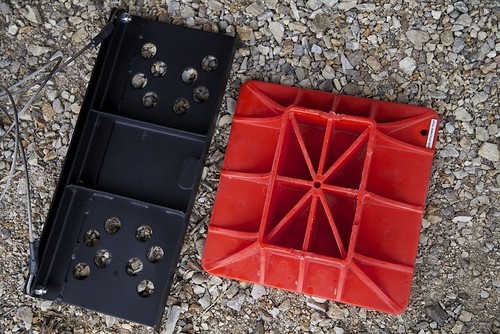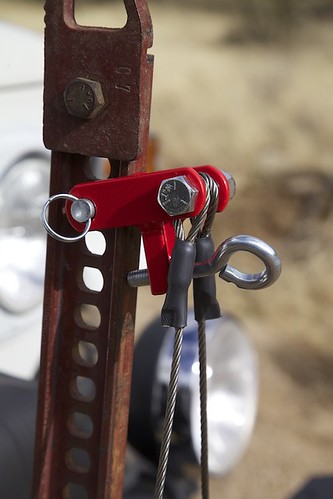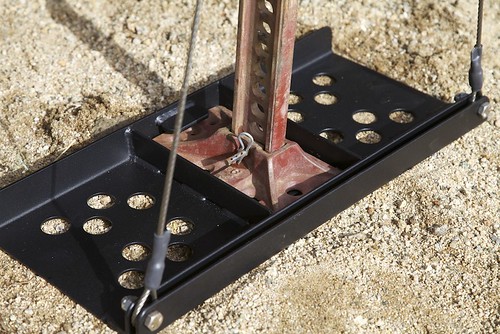Transform your Hi-Lift jack

It isn’t very often I test a product that defies criticism even when subjected to the harshest analysis. But I’ve just been using a brand new accessory for the Hi-Lift jack, and I find myself at a loss to write anything that would approach even the level of nitpicking.
Anyone who has used a Hi-Lift jack knows it will do things no other jack will do. Anyone who has used one also knows the thing is a widow-maker if not handled with the same circumspection one would employ with a pissed-off rattlesnake. The operating handle continuously lies in wait for the head of a careless user to stray within its arc of movement. (Lose your grip then and a broken nose would be light punishment.) The lift mechanism is prone to jamming until doused with WD-40, and the selector lever frequently requires a stomp with a boot rather than a push with a finger to switch from “raise” to “lower.”
Then there’s stability. Now and then you want an unstable Hi-Lift, when using it as a “casting jack” to raise one end of a vehicle and then tip it sideways out of a rut. Far more often, the thing tips on its own when you don’t want it to. Woe to anyone trying to insert sand mats under the tires at that point—much less anyone attempting to change a tire. And human body parts are not all that are at risk: The Hi-Lift’s main beam will crease truck-body sheet metal effortlessly if the vehicle tips away from the baseplate.
Until now we just put up with these hazards to exploit the inarguable versatility of Bloomfield Manufacturing’s century-old invention. Now Richard Bogert of Bogert Manufacturing has solved one of the Hi-Lift’s salient drawbacks with a product of palm-to-forehead simplicity.
The Safe Jack comprises a sturdy, powdercoated steel baseplate into which the base of the Hi-Lift slots snugly. The plate offers exactly the increase in area (144 square inches total) as the ubiquitous orange plastic ORB jack base, to enhance flotation in soft sand or mud.
 The Safe Jack base (left) offers the same flotation as the plastic base
The Safe Jack base (left) offers the same flotation as the plastic base
But the brilliance of the Safe Jack lies in the two swaged steel cables bolted to each corner of the base, which triangulate the jack’s structure by connecting to the top of the main beam with a quick-connect clevis pin. The user tensions the cables by simply screwing in an eyebolt snug against the main beam, and . . . shazam: Suddenly that tippy Hi-Lift is the Rock of Gibraltar. I raised the front of my FJ40 with the Hi-Lift a foot off-center—normally a recipe for a drunken sideways flop as soon as the weight comes off the tires—hung both wheels in the air, then shoved sideways on the vehicle. Nothing—it rocked an inch or two and settled back comfortably. The total extra time to set up the Safe Jack system was maybe 30 seconds.
 The Safe Jack's cables attach with a pin and tension with a simple eyebolt.
The Safe Jack's cables attach with a pin and tension with a simple eyebolt.
In the end, I found one small thing I thought would improve the Safe Jack, although it’s far from a criticism: I plan to replace the bolts securing the bottom ends of the cables with clevis pins and J-clips. That way if I want just the base I can quickly remove the cables to keep them out of the way.
The Safe Jack provides all the flotation benefits of an expanded baseplate, then adds a different universe of stability and safety. I’m finding myself viewing my 20-year-old Hi-Lift as an entirely new tool. If you’re a Hi-Lift jack owner—or have avoided buying one because of all the horror stories you’ve heard—trust me, this accessory will change the way you view your jack too. For 69 bucks it’s a steal.
The Safe Jack is available direct from Bogert Manufacturing: Go here. They also make some intriguing accessories for bottle jacks which I hope to test soon.

An update, if you missed it elsewhere. Bogert has improved an already excellent product by modifying the top piece. See the review here. It's available as a very affordable upgrade if you bought the original version.
